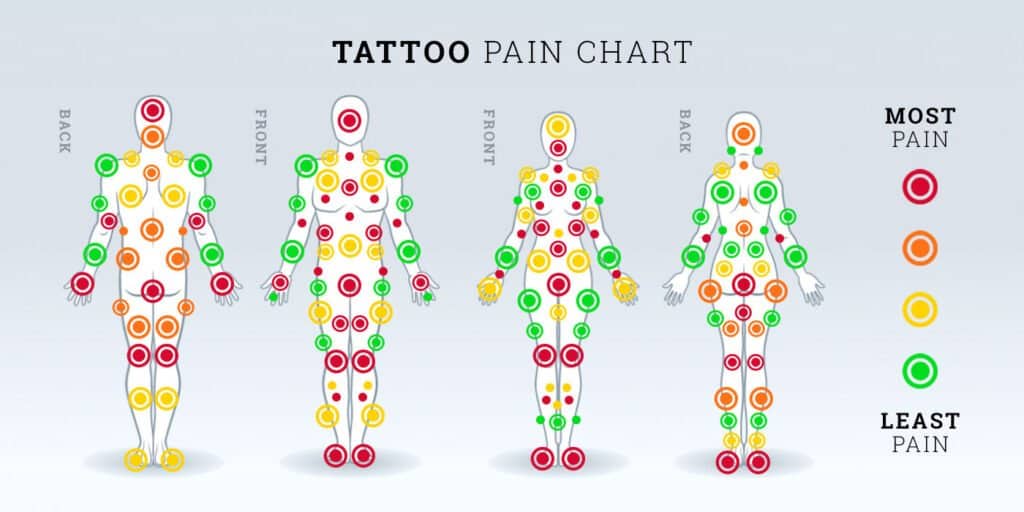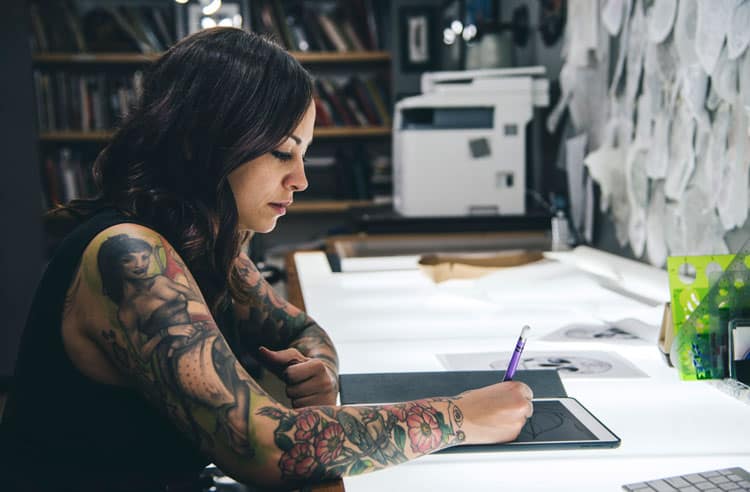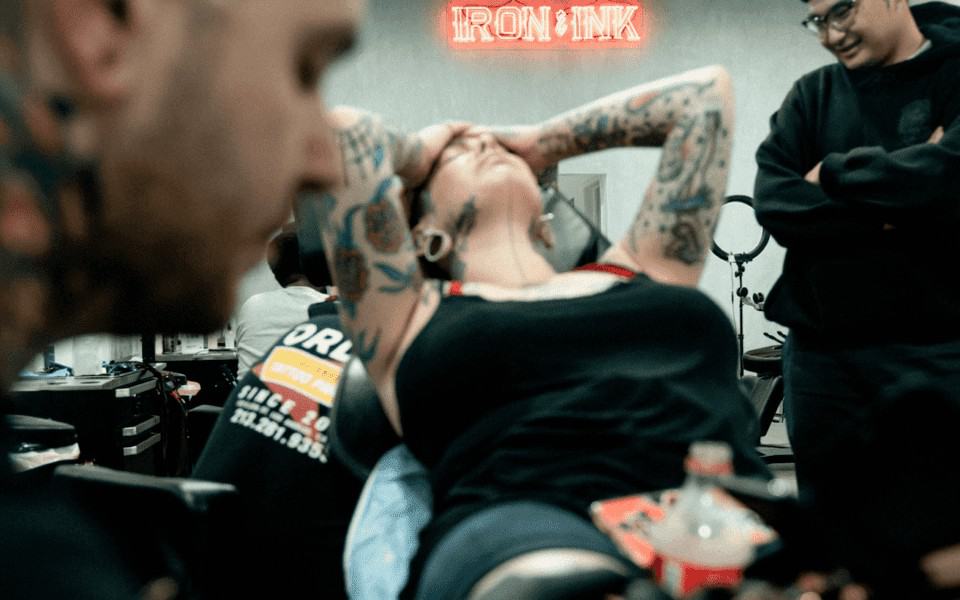Depending on the individual feeling, the pain of a tattoo can be more or less intense. The cool needle touches the skin, then digs in, and the nerve endings relay an impulse to the brain. What you feel is a sharp, stabbing pain. People sensitive to pain can counteract this by selecting suitable parts of the body. This article aims to make you aware of all the body parts where getting a tattoo hurts the most and the least.
But first, let’s understand why it hurts
Adipose tissue relieves pain
The less the amount of fatty tissue between the skin, muscles and tendons, the more painful it will be to get tattoos in these places. Since muscles and tendons are particularly densely intergrown with nerves, it hurts when the needle hits them. Examples of such sensitive areas are wrists and feet. In the case of fatty tissue, on the other hand, the needle is kept away from nerves. Therefore, places with a lot of fatty tissue such as upper arms or thighs are ideal for a tattoo.
Areas with few nerves hurt less
In addition to well-padded areas, gaunt areas also reduce the pain of a tattoo. If there are only bones under the skin, this can reduce the pain effect, since there are usually more nerve endings in muscles and tendons. Places like the lateral forearm along the elbow bone, for example, hurt little. Such body parts are not only suitable for pain-relieving reasons, but at the same time, these are usually body regions that sag less quickly. A tattoo will look better here in a few years than in well-padded areas. Of course, there are exceptions here: along the spinal cord, for example, a particularly large number of nerves meet.
Your skin plays a major part!
Often the pain effect is caused by spasms. Strained limbs harden and the tattoo then hurts all the more. Take a deep breath and relax as you prick. Pain can usually be breathed away because conscious breathing releases tension. Staring at the needle, on the other hand, can be counterproductive. Turn away if you fear needles, which can also relieve the tugging on the skin. If it’s your first tattoo or needs to know about tattoo removal, you have to take extra care about where you’re getting it.
Art on the skin and tattooing have now achieved general societal acceptance. Even permanently visible tattoos on uncovered parts of the body do not represent a blemish in your life. You often decide where the needle can be applied and where the motifs find their place, based on their sensitivity to pain. Everyone has different skin and individual pain tolerance. The basic physiological conditions and properties of the largest body organ, the skin, are similar. The so-called sensitive areas can be found where little fat pads and thin skin are mostly covered and where pain receptors are closely distributed to send signals to the nerves. Your perceived pain is composed of touch, pressure, temperature and vibration. All these impulses arise when you get a tattoo.
Structure and thickness of the skin
Your skin is roughly divided into three layers. The surface forms the epidermis, the dermis lies underneath and the subcutaneous tissue forms the connection to the inside of the body. Your epidermis is constantly renewed. The tattoo ink is placed in the dermis. The thickness of the layers of skin and the skin as a whole depends on the depth of the prick. In general, the deeper the prick, the more nerve endings will report pain. On parts of the body with thin skin, the nerves are higher and are “caught” faster and in larger numbers. In the case of large-area motifs, the evenness of the dye incorporation is done by repeated pricking and filling. These basic conditions result in similar pain patterns and sensations in almost all people.
The most painful spots
A tattoo is never painless! But among all the parts of the body, some areas are even worse than others.
The skull
Imagine that pain when you have your little hair pulled. Getting a head tattoo is a bit like that, only worse. Not only does it really hurt, but in addition, the pain felt is accentuated by the proximity of the ears!
Hands
The hands concentrate most of our sense of touch. By definition, they are therefore very sensitive. If you are not ready to have pain, it is better to orient yourself on a more classic, but more bearable forearm tattoo!
The wrist
A small tattoo on the wrist is elegant and discreet. The thinness of the skin and the presence, very close under the epidermis, of the veins, makes the area quite painful. But as the saying goes, “you have to suffer to be beautiful”.
The elbow
If you are getting a tattoo on your arm, it is possible that the design will go through your elbow. Get ready to grit your teeth at that moment! Without certainty, however, because some say that it hurts very badly, while others that they did not feel anything.
The lower abdomen
Although very sexy, a tattoo for women, or for men, on the lower abdomen is not painless! Have you ever had abdominal soreness? Well, it will be worse! No, even if you have a small bulge, it won’t help you have less pain!
The back of the knee
Women who wax can testify – the knee is very sensitive! If a simple strip of wax brings tears to our eyes, imagine the result with a needle. As for the back of the knee, get ready, it tickles!
Ankle
Getting a phrase tattooed around your ankle is very trendy! Having the tattoo of your dreams is worth it, so don’t expect a cakewalk. However, it hurts less than rumour would have you believe.
Buttocks
One might think that this slightly padded area is, suddenly, less painful to tattoo. Nevertheless, it is not the case. Be prepared to have a little trouble sitting down for a few hours.
For the brave, but not reckless, who do not want to hurt, there is always the temporary tattoo. Painless, of course, but perhaps the first step is to make up your mind for good!
The less painful spots
Shoulder
With relatively few pain receptors and thick, firm skin on stable connective tissue helps prevent pain while you get inked.
Neck
Muscular and taut with thick skin help you stay relaxed while getting your favourite tattoo.
Hip
Getting a tattoo on your hips is more uncomfortable than painful.
Outer upper arm
Insensitive thick skin and equipped with few pain receptors, the outer upper arm is a great spot for you if you don’t want the pain.
Shin’s bone
This is an insensitive place to get a tattoo despite little fat padding, as there are few receptors.
Calf
With good relaxation, almost pain-free tattoos can be formed on your calves.
Chest
The intensity of the pain in your chest depends on gender and exact location. However, the pain is not much for either gender.

Some physical requirements to take care of
How sensitive your body reacts to pain also depends on your body’s constitution. In general, the pain level decreases when there is more tissue of fat or muscle under the skin. The strength and tightness of the connective tissue also affect how you feel. In addition to the general physiological requirements, these factors influence how much pain you feel and have to endure when tattooing. In physically sensitive areas, the pain level also decreases. In sensitive and painful areas, good padding can reduce pain. A fit and trained tissue usually send fewer pain signals off.
Neural pathways and pain perception
On a square centimetre of your skin, there are between 10 and 200 receptors that record pain and report it to your brain. Among these receptors, responding to different stimuli, there are faster and slower classes. Your ultimate perception of pain arises from the interplay. These symptoms, known as afferents, intensify with their dynamics. Your body gives your brain the warning signal of pain and deduces from your reaction (excitement, increase in heart rate ) that further pain messages must be given. If you “tell” your body during the tattooing that you have everything under control despite the nerve reaction, you can reinforce and slow pain intensity.
Psychological factors
Pain is a highly subjective feeling. While one sticks a needle through his hand without feeling it, another screams at the slightest bump against an obstacle. The selection of body parts for tattooing should be made according to your character, your experiences and your type. It makes sense to approach the potentially pain-critical regions only after “harmless” tattoos. If you already know the feeling of the needle, you can adjust to it more calmly. Especially in those who are physiologically sensitive to pain, your attitude and behaviour are decisive. If you are and remain relaxed, the pain will also remain manageable. Only get tattooed when you are mentally fresh and not taking any intoxicating or sensory-distorting substances.
The fact is, tattooing hurts. So there is no way around pain during tattooing.
But: You can influence the intensity of the pain at least a little bit.
Expectation
Expectations play a far greater role concerning pain than one might think. If you expect it to be painful, it will be. If you are convinced that it won’t be as bad, you will also feel the tattoo painless. The miracle cure that steps in here is our psyche. It influences many things in life. And also the feeling of pain.
Relaxation
Relax. How many times have you heard these words? Relaxation also works wonders when it comes to tattoos. The tenser you are, the more pain you will feel.
Tip: watch your breathing. Breathe in and out calmly. You’ll see it works.
Diversion
Another proven way to reduce pain perception is a distraction. Talk to the tattoo artist, listen to music, and take a good look at the room. Whatever distracts you, do it. Of course, this only means things that do not interfere with the tattoo artist’s work. After all, he should immortalize a small work of art in your skin and not make any mistakes.
Accompaniment
Do you feel more comfortable and relaxed during your tattoo appointment when accompanied? No problem, bring someone with you. Whether it’s for a supportive handshake or a chat as a distraction, bringing someone to tattoo is always a good idea.
Pause
Of course, it can also happen that the pain, especially in the sensitive parts of the body, becomes too much. In such cases, please don’t be afraid to ask the tattoo artist for a break. For one thing, he’s dealt with a large number of tattoo fans throughout his career, and there must have been some who needed a break. On the other hand, he would certainly prefer you to take a break than to get tense and the tattooing to become a strenuous event for both of you.
A short break during the tattooing process will help you to relax again. Your skin will also calm down a little in this short time. After that, it becomes easier to endure the tattoo pain again.
No medication
You may consider taking medication such as painkillers before getting a tattoo. However, this is not advisable.
The reason for this is the fact that some medications, including many painkillers, have a blood-thinning effect. And that’s not a good thing when it comes to tattooing.
If you want to take something to relieve the pain, then do it only after consulting a doctor. And you should also inform your tattoo artist that you have taken something.
My advice: Enjoy your tattoo. Be relaxed and think positively. Tattooing may be painful, but the result is worth it.
To conclude
You want your tattoo experience to be a positive one and something that you can endure. However, if you are still adamant about getting a tattoo on a painful part of the body, there are certain things that you can do to keep yourself stable during the process. Having knowledge of basics like things to know before getting a first tattoo helps you expect and handle the pain while tattooing.

